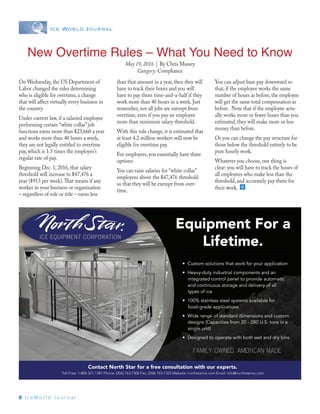10-06-16 IWJO_070_NorthStarAd
•
0 likes•22 views
The US Department of Labor changed the rules for determining overtime eligibility. Beginning in December 2016, the salary threshold for exempt "white collar" employees will increase from $23,660 to $47,476 per year. This means that if any employee earns less than the new threshold, their employer will have to pay them overtime (1.5 times their regular pay rate) for any hours worked over 40 in a week. It is estimated that over 4 million additional workers will now qualify for overtime pay due to this rule change. Employers have three options to comply with the new rules: raise salaries above the threshold; adjust base pay downward while maintaining the same total pay; or change pay structures to hourly for affected employees. All
Report
Share
Report
Share
Download to read offline

Recommended
Recommended
More Related Content
Similar to 10-06-16 IWJO_070_NorthStarAd
Similar to 10-06-16 IWJO_070_NorthStarAd (20)
Implementing the Overtime Regulations: 5 Steps to Controlling Costs

Implementing the Overtime Regulations: 5 Steps to Controlling Costs
Stark Company has five employees. Employees paid by the hour receive.pdf

Stark Company has five employees. Employees paid by the hour receive.pdf
Labor & Employment Bulletin - Department of Labor Issues New Rule for Overtim...

Labor & Employment Bulletin - Department of Labor Issues New Rule for Overtim...
FLSA Overtime Rule Changes: Preparing for Compliance

FLSA Overtime Rule Changes: Preparing for Compliance
Wage and Hour Compliance: Is Your Business Ready for the New Regulations?

Wage and Hour Compliance: Is Your Business Ready for the New Regulations?
Proposed DOL Rule May Make Millions More Eligible for Overtime Pay

Proposed DOL Rule May Make Millions More Eligible for Overtime Pay
10-06-16 IWJO_070_NorthStarAd
- 1. 8 I c e W o r l d J o u r n a l Ice World Journal New Overtime Rules – What You Need to Know May 19, 2016 | By Chris Massey Category: Compliance On Wednesday, the US Department of Labor changed the rules determining who is eligible for overtime, a change that will affect virtually every business in the country. Under current law, if a salaried employee performing certain “white collar”job functions earns more than $23,660 a year and works more than 40 hours a week, they are not legally entitled to overtime pay, which is 1.5 times the employee’s regular rate of pay. Beginning Dec. 1, 2016, that salary threshold will increase to $47,476 a year ($913 per week).That means if any worker in your business or organization – regardless of role or title – earns less than that amount in a year, then they will have to track their hours and you will have to pay them time-and-a-half if they work more than 40 hours in a week. Just remember, not all jobs are exempt from overtime, even if you pay an employee more than minimum salary threshold. With this rule change, it is estimated that at least 4.2 million workers will now be eligible for overtime pay. For employers, you essentially have three options: You can raise salaries for “white collar” employees above the $47,476 threshold so that they will be exempt from over- time. You can adjust base pay downward so that, if the employee works the same number of hours as before, the employee will get the same total compensation as before. Note that if the employee actu- ally works more or fewer hours than you estimated, they will make more or less money than before. Or you can change the pay structure for those below the threshold entirely to be pure hourly work. Whatever you choose, one thing is clear: you will have to track the hours of all employees who make less than the threshold, and accurately pay them for their work.